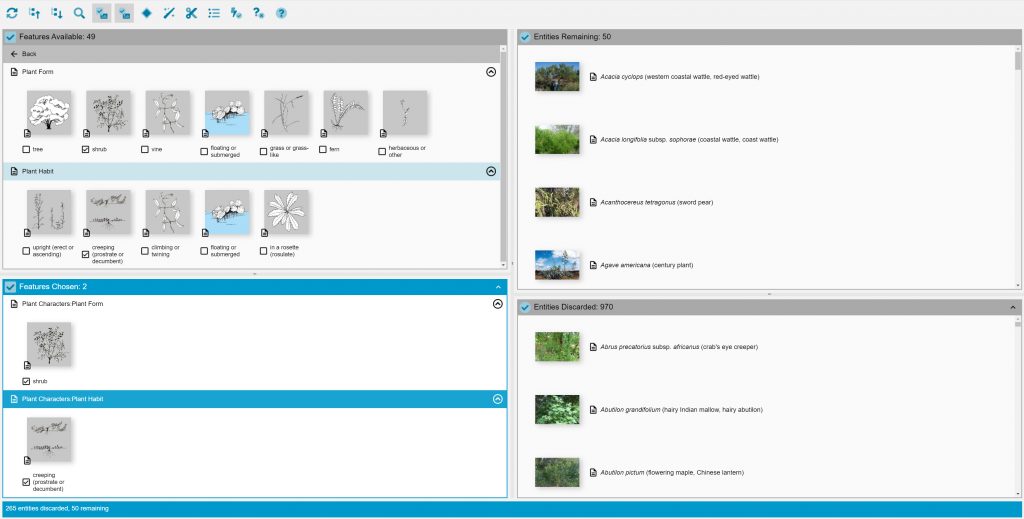Lucid Player System Requirements

Lucid Player v4 Help


The Lucid Player is an effective and powerful identification and diagnostic tool. It is used to play interactive identification or diagnostic keys or guides created using the Lucid Builder.
Lucid keys are usually created by an expert for a particular group of organisms or things (such as fruit flies, frogs, wild flowers, corals, grasses, crop diseases, mouth ulcers or minerals). The key comprises a list of all the Entities (E.g. Species or other taxa, objects, diseases etc.) in the group, a list of the Features that may be used to identify them, and a matrix of scores of the Entities for the features.
When a key is deployed in the Lucid Player, it can be used to identify specimens that belong to the group covered. Specimens are described by selecting, from the list of all Features provided in the key, those Features that match the specimen. At each step, the Lucid Player sorts the list of Entities in the key into those that match the developing description and those that do not. As Features are progressively chosen, the list of matching entities will be progressively reduced until a single Entity (or perhaps a short list of entities) remains. The identification is complete.
Identifying the specimen – finding a name for it – is only the first step in finding out more about it. Links from the key’s entities provide access to fact sheets and other information provided by the key builder. A name is also the starting point for finding information on an organism beyond the key, using the Internet and other resources.
The Lucid Player provides other tools and information to help with the identification. For example, features in Lucid keys are usually provided with explanatory notes and images to help learn about them. Subsets of Features can help organise the list of features to make it easier to manage, and the Player’s Best function is a powerful tool to help decide which feature to address next.
View the topic Using the Lucid Player next, for an introduction to the look and feel of the Player.
If you think you may like to build your own Lucid key, see the topic What does the Lucid Builder do? Or visit https://www.lucidcentral.org, for more information.


Welcome to the Lucid Player, one member of the Lucid family of products. For more information on other Lucid and related programs, please visit the Lucidcentral website at https://www.lucidcentral.org.
Written entirely in JavaScript, this latest edition of the Lucid Player is cross-platform, and will run within any modern web browser (Edge, Chrome, Firefox, Safari and Opera.), under any operating system (such as Windows, Macintosh, Unix, Linux, Sun Solaris etc).
Unlike the older Java Applet or Desktop editions of the Lucid Player, the Java Runtime Environment (JRE) is not required.

The Lucid Player provides the end user the interface for interacting with an identification key created in the Lucid Builder. The Lucid Player supports loading both matrix (random access) and dichotomous keys.
The Lucid Player comprises a main window presenting to the user four lists regardless of the type of key loaded:
Top left window
Matrix key:
Features Available – lists all features and their states that may be used to describe the specimen to be identified
Dichotomous key:
Questions (couplets) Available – holds the questions that need to be addressed at each step (branch point) of the key.
Left bottom window
Matrix key:
Features Chosen – displays features that have been chosen.
Dichotomous key:
History – displays a list of questions that have been answered.
Top right window
Matrix & Dichotomous key:
Entities Remaining – lists all entities in the key that still remain as possible identifications of the specimen being investigated, given the features/questions that have been chosen.
Bottom right window
Matrix & Dichotomous key:
Entities Discarded – lists all entities in the key that have been excluded as a result of the chosen features or answered questions.
—
When a key is first started, Features Chosen/History and Entities Discarded are empty. A user chooses states of features or answers questions by ticking their check-boxes. In response, the Player progressively removes from Entities Remaining those entities that do not match the chosen states/questions.
By choosing more and more features or questions, the list in Entities Remaining will be gradually reduced until, perhaps, a single entity remains – the specimen has been identified.
In addition to the basic lists of features and entities, a well-designed Lucid key also provides help to users through pictures and web pages illustrating and explaining features and their states, pages with extra information on the entities in the key, feature and entity subsets and dependencies to help organise and streamline the lists.
Please see the Lucid Player Help for more information.
